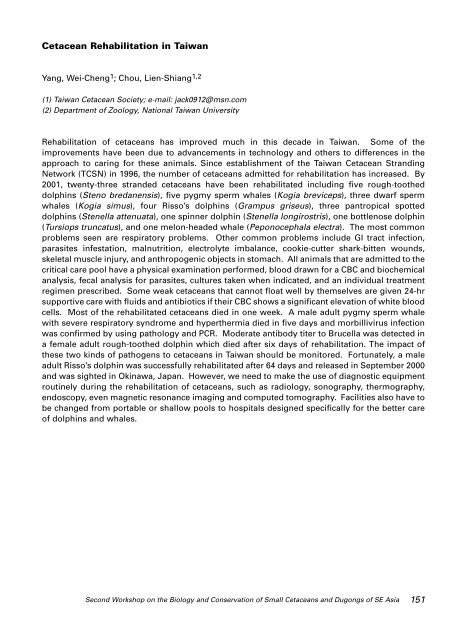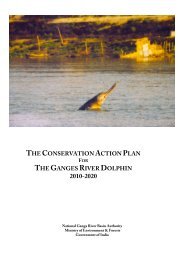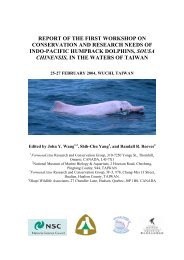Cetacean Rehabilitati<strong>on</strong> in TaiwanYang, Wei-Cheng 1 ; Chou, Lien-Shiang 1,2(1) Taiwan Cetacean Society; e-mail: jack0912@msn.com(2) Department <str<strong>on</strong>g>of</str<strong>on</strong>g> Zoology, Nati<strong>on</strong>al Taiwan UniversityRehabilitati<strong>on</strong> <str<strong>on</strong>g>of</str<strong>on</strong>g> cetaceans has improved much in this decade in Taiwan. Some <str<strong>on</strong>g>of</str<strong>on</strong>g> <str<strong>on</strong>g>the</str<strong>on</strong>g>improvements have been due to advancements in technology <strong>and</strong> o<str<strong>on</strong>g>the</str<strong>on</strong>g>rs to differences in <str<strong>on</strong>g>the</str<strong>on</strong>g>approach to caring for <str<strong>on</strong>g>the</str<strong>on</strong>g>se animals. Since establishment <str<strong>on</strong>g>of</str<strong>on</strong>g> <str<strong>on</strong>g>the</str<strong>on</strong>g> Taiwan Cetacean Str<strong>and</strong>ingNetwork (TCSN) in 1996, <str<strong>on</strong>g>the</str<strong>on</strong>g> number <str<strong>on</strong>g>of</str<strong>on</strong>g> cetaceans admitted for rehabilitati<strong>on</strong> has increased. By2001, twenty-three str<strong>and</strong>ed cetaceans have been rehabilitated including five rough-too<str<strong>on</strong>g>the</str<strong>on</strong>g>ddolphins (Steno bredanensis), five pygmy sperm whales (Kogia breviceps), three dwarf spermwhales (Kogia simus), four Risso’s dolphins (Grampus griseus), three pantropical spotteddolphins (Stenella attenuata), <strong>on</strong>e spinner dolphin (Stenella l<strong>on</strong>girostris), <strong>on</strong>e bottlenose dolphin(Tursiops truncatus), <strong>and</strong> <strong>on</strong>e mel<strong>on</strong>-headed whale (Pep<strong>on</strong>ocephala electra). <strong>The</strong> most comm<strong>on</strong>problems seen are respiratory problems. O<str<strong>on</strong>g>the</str<strong>on</strong>g>r comm<strong>on</strong> problems include GI tract infecti<strong>on</strong>,parasites infestati<strong>on</strong>, malnutriti<strong>on</strong>, electrolyte imbalance, cookie-cutter shark-bitten wounds,skeletal muscle injury, <strong>and</strong> anthropogenic objects in stomach. All animals that are admitted to <str<strong>on</strong>g>the</str<strong>on</strong>g>critical care pool have a physical examinati<strong>on</strong> performed, blood drawn for a CBC <strong>and</strong> biochemicalanalysis, fecal analysis for parasites, cultures taken when indicated, <strong>and</strong> an individual treatmentregimen prescribed. Some weak cetaceans that cannot float well by <str<strong>on</strong>g>the</str<strong>on</strong>g>mselves are given 24-hrsupportive care with fluids <strong>and</strong> antibiotics if <str<strong>on</strong>g>the</str<strong>on</strong>g>ir CBC shows a significant elevati<strong>on</strong> <str<strong>on</strong>g>of</str<strong>on</strong>g> white bloodcells. Most <str<strong>on</strong>g>of</str<strong>on</strong>g> <str<strong>on</strong>g>the</str<strong>on</strong>g> rehabilitated cetaceans died in <strong>on</strong>e week. A male adult pygmy sperm whalewith severe respiratory syndrome <strong>and</strong> hyper<str<strong>on</strong>g>the</str<strong>on</strong>g>rmia died in five days <strong>and</strong> morbillivirus infecti<strong>on</strong>was c<strong>on</strong>firmed by using pathology <strong>and</strong> PCR. Moderate antibody titer to Brucella was detected ina female adult rough-too<str<strong>on</strong>g>the</str<strong>on</strong>g>d dolphin which died after six days <str<strong>on</strong>g>of</str<strong>on</strong>g> rehabilitati<strong>on</strong>. <strong>The</strong> impact <str<strong>on</strong>g>of</str<strong>on</strong>g><str<strong>on</strong>g>the</str<strong>on</strong>g>se two kinds <str<strong>on</strong>g>of</str<strong>on</strong>g> pathogens to cetaceans in Taiwan should be m<strong>on</strong>itored. Fortunately, a maleadult Risso’s dolphin was successfully rehabilitated after 64 days <strong>and</strong> released in September 2000<strong>and</strong> was sighted in Okinawa, Japan. However, we need to make <str<strong>on</strong>g>the</str<strong>on</strong>g> use <str<strong>on</strong>g>of</str<strong>on</strong>g> diagnostic equipmentroutinely during <str<strong>on</strong>g>the</str<strong>on</strong>g> rehabilitati<strong>on</strong> <str<strong>on</strong>g>of</str<strong>on</strong>g> cetaceans, such as radiology, s<strong>on</strong>ography, <str<strong>on</strong>g>the</str<strong>on</strong>g>rmography,endoscopy, even magnetic res<strong>on</strong>ance imaging <strong>and</strong> computed tomography. Facilities also have tobe changed from portable or shallow pools to hospitals designed specifically for <str<strong>on</strong>g>the</str<strong>on</strong>g> better care<str<strong>on</strong>g>of</str<strong>on</strong>g> dolphins <strong>and</strong> whales.<str<strong>on</strong>g>Sec<strong>on</strong>d</str<strong>on</strong>g> <str<strong>on</strong>g>Workshop</str<strong>on</strong>g> <strong>on</strong> <str<strong>on</strong>g>the</str<strong>on</strong>g> <strong>Biology</strong> <strong>and</strong> C<strong>on</strong>servati<strong>on</strong> <str<strong>on</strong>g>of</str<strong>on</strong>g> Small Cetaceans <strong>and</strong> Dug<strong>on</strong>gs <str<strong>on</strong>g>of</str<strong>on</strong>g> SE Asia 151
Status <strong>and</strong> C<strong>on</strong>servati<strong>on</strong> <str<strong>on</strong>g>of</str<strong>on</strong>g> Irrawaddy dolphins Orcaella brevirostris inMalampaya Sound, Palawan, PhilippinesSmith, Brian D. 1 ; Beasley, Isabel 2 ; Buccat, Mariel 3 ; Calder<strong>on</strong>, Victor 3 ; Evina, Roderick 3 ; del Valle,Joseph Lemmuel 3 ; Cadigal, Angela 3 ; Tura, Emmalyn 3 ; Visitaci<strong>on</strong>, Zhuljakim 3(1) Wildlife C<strong>on</strong>servati<strong>on</strong> Society, 27/17 Soy Naya, Moo 1 Muang, Rawai, Phuket 83130 Thail<strong>and</strong>(2) School <str<strong>on</strong>g>of</str<strong>on</strong>g> Tropical Envir<strong>on</strong>mental Studies, James Cook University, Townsville, Queensl<strong>and</strong>4811 Australia(3) Kabang Kalikasan Ng Philipinas (World Wide Fund for Nature– Philippines) 23 Maalindog Street,U.P. Village, Diliman, Quez<strong>on</strong> City 1101 PhilippinesA geographically isolated populati<strong>on</strong> <str<strong>on</strong>g>of</str<strong>on</strong>g> Irrawaddy dolphins was recently discovered inMalampaya Sound, Palawan, Philippines. Line-transect surveys c<strong>on</strong>ducted in April – November2001 covered 884km <str<strong>on</strong>g>of</str<strong>on</strong>g> trackline <strong>and</strong> resulted in a total populati<strong>on</strong> estimate <str<strong>on</strong>g>of</str<strong>on</strong>g> 77 individuals(CV=27.4%), c<strong>on</strong>fined to <str<strong>on</strong>g>the</str<strong>on</strong>g> inner porti<strong>on</strong> (133.7km 2 ). For all Irrawaddy dolphin sightings, whereecological data were collected (n=47), <str<strong>on</strong>g>the</str<strong>on</strong>g> mean temperature was 30.20°C, depth 6.5 m, salinity28.3 ppt, <strong>and</strong> turbidity 2.2 NTUs. Significantly higher turbidity, lower salinity, <strong>and</strong> shallower depthwere recorded in <str<strong>on</strong>g>the</str<strong>on</strong>g> inner Sound compared to adjacent waters. Bottlenose dolphins Tursiopssp. (probably truncatus) were observed in waters just outside <str<strong>on</strong>g>of</str<strong>on</strong>g> where Irrawaddy dolphins wererecorded. During <str<strong>on</strong>g>the</str<strong>on</strong>g> study, two Irrawaddy dolphins were accidentally killed in bottom-set nyl<strong>on</strong>gill nets used to catch crabs, locally called matang quatro. <str<strong>on</strong>g>Report</str<strong>on</strong>g>s from local fishermen alsoindicated that as many as three additi<strong>on</strong>al animals may have been killed in <str<strong>on</strong>g>the</str<strong>on</strong>g>se nets during<str<strong>on</strong>g>the</str<strong>on</strong>g> same period. <strong>The</strong>se findings suggest str<strong>on</strong>gly that <str<strong>on</strong>g>the</str<strong>on</strong>g> Irrawaddy dolphin populati<strong>on</strong> inMalampaya Sound is in immediate danger <str<strong>on</strong>g>of</str<strong>on</strong>g> extirpati<strong>on</strong> due to low numbers, limited range,<strong>and</strong> high mortality. This is <str<strong>on</strong>g>the</str<strong>on</strong>g> <strong>on</strong>ly known populati<strong>on</strong> <str<strong>on</strong>g>of</str<strong>on</strong>g> <str<strong>on</strong>g>the</str<strong>on</strong>g> species in <str<strong>on</strong>g>the</str<strong>on</strong>g> Philippines, <strong>and</strong> <str<strong>on</strong>g>the</str<strong>on</strong>g>nearest area where ano<str<strong>on</strong>g>the</str<strong>on</strong>g>r populati<strong>on</strong> is known to occur is in nor<str<strong>on</strong>g>the</str<strong>on</strong>g>rn Borneo, some 550 kmto <str<strong>on</strong>g>the</str<strong>on</strong>g> south. Recommendati<strong>on</strong>s for c<strong>on</strong>serving <str<strong>on</strong>g>the</str<strong>on</strong>g> populati<strong>on</strong> include that (1) socioec<strong>on</strong>omicalternatives be developed to promote <str<strong>on</strong>g>the</str<strong>on</strong>g> c<strong>on</strong>servati<strong>on</strong> goal <str<strong>on</strong>g>of</str<strong>on</strong>g> reducing <str<strong>on</strong>g>the</str<strong>on</strong>g> incidence <str<strong>on</strong>g>of</str<strong>on</strong>g> dolphinentanglement in matang quatro gillnets; (2) gillnet free z<strong>on</strong>es be established in core areas <str<strong>on</strong>g>of</str<strong>on</strong>g>dolphin distributi<strong>on</strong>; (3) Irrawaddy dolphins be promoted as a flagship species <str<strong>on</strong>g>of</str<strong>on</strong>g> envir<strong>on</strong>mentalhealth in <str<strong>on</strong>g>the</str<strong>on</strong>g> Sound; (4) a l<strong>on</strong>g-term program be established to m<strong>on</strong>itor <str<strong>on</strong>g>the</str<strong>on</strong>g> dolphin populati<strong>on</strong>;<strong>and</strong> (5) fur<str<strong>on</strong>g>the</str<strong>on</strong>g>r research be c<strong>on</strong>ducted <strong>on</strong> fisheries <strong>and</strong> dolphin interacti<strong>on</strong>s, with particularemphasis <strong>on</strong> gillnets.152 CMS Technical Series Publicati<strong>on</strong> Nº 9 - 2005
- Page 1 and 2:
CMS Technical Series Publication N
- Page 3 and 4:
Published by the U
- Page 5 and 6:
TABLE OF CONTENTSpage1. Preliminari
- Page 7 and 8:
AppendicesAppendix 1 - List <strong
- Page 9 and 10:
8 CMS Technical Series Publication
- Page 11 and 12:
10 CMS Technical Series Publication
- Page 13 and 14:
The cetacean species reviewed inclu
- Page 15 and 16:
Table 1. Major commercial Commonwea
- Page 17 and 18:
(2) State Legislation.In state wate
- Page 19 and 20:
(2) Identification of</stro
- Page 21 and 22:
Coastal speciesThe most frequently
- Page 23 and 24:
Coastal speciesThere are currently
- Page 25 and 26:
and Guangxi Provinces (Yang et al.
- Page 27 and 28:
Table 3. Records of</strong
- Page 29 and 30:
can be viewed as the</stron
- Page 31 and 32:
Workshop participa
- Page 33 and 34:
ioaccumulation have not yet been ex
- Page 35 and 36:
of fishermen who h
- Page 37 and 38:
are supplied to scholars and organi
- Page 39 and 40:
threats. Many marine mammal populat
- Page 42:
waters or recognize important inter
- Page 47 and 48:
James Cook University (Queensland,
- Page 49 and 50:
the last ten years
- Page 51 and 52:
proactive in engaging more staff an
- Page 53 and 54:
of SE Asia. Two sp
- Page 55 and 56:
San Francisco (Negros Oriental); Li
- Page 57 and 58:
Legal status and present management
- Page 59 and 60:
within 15 kilometers from t
- Page 61 and 62:
US, has actively participated in ce
- Page 63 and 64:
the project was su
- Page 65 and 66:
Recently, the camp
- Page 67 and 68:
Mekong River downstream of<
- Page 69 and 70:
porpoises in tropical waters <stron
- Page 71 and 72:
species in the Ind
- Page 73 and 74:
Population/stock structureNo new in
- Page 75 and 76:
Needs for additional researchStock
- Page 77 and 78:
waters of SE Asia,
- Page 79 and 80:
caused mortality is certainly large
- Page 81 and 82:
Needs for additional researchProper
- Page 83 and 84:
from SE Asia, it is known to occur
- Page 85 and 86:
3.1.7 AustraliaDugongs occur all al
- Page 87 and 88:
Table 8. Conservation objectives id
- Page 89 and 90:
3) Monitoring and assessment <stron
- Page 91 and 92:
Table 10. Outline of</stron
- Page 93 and 94:
The group agreed that this set <str
- Page 95 and 96:
6. SUMMARY AND CONCLUSIONSThe works
- Page 97 and 98:
96 CMS Technical Series Publication
- Page 99 and 100:
Bank, E. 1931. A popular account <s
- Page 101 and 102: Dalebout, M. L., J. G. Mead, C. Sco
- Page 103 and 104: Jaaman, S. A., E. Tangon, I. Isnain
- Page 105 and 106: Lin, Y.-J. 1997. Mitochondrial DNA
- Page 107 and 108: Smith, B.D., T. A. Jefferson, D. Ho
- Page 109 and 110: Yang, W.-C. 2000. Morbillivirus inf
- Page 111 and 112: CHOU Lien-SiangDepartment o
- Page 113 and 114: Brian D. SMITHWildlife Conservation
- Page 115 and 116: APPENDIX 3Agenda1. Preliminaries2.
- Page 117 and 118: Doc. 22 Dugong conservation activit
- Page 119 and 120: AreaDatesSurveyTypeEffortSpeciesNo.
- Page 121 and 122: AreaDatesSurveyTypeEffortSpeciesNo.
- Page 123 and 124: AreaDatesSurveyTypeEffortSpeciesNo.
- Page 125 and 126: Phase ofActionPlan
- Page 127 and 128: [Small cetaceans are defined to inc
- Page 129 and 130: f) recognizing that by-catch in fis
- Page 131 and 132: 130 CMS Technical Series Publicatio
- Page 133 and 134: APPENDIX 9Abstracts of</str
- Page 135 and 136: The (IUCN Critically Endangered) Du
- Page 137 and 138: Status of
- Page 139 and 140: Cetacean Habitats in the</s
- Page 141 and 142: Conservation of <s
- Page 143 and 144: Summary of Current
- Page 145 and 146: Indonesia’s Cetacean Migration Co
- Page 147 and 148: Conservation Effort to Protect <str
- Page 149 and 150: The Status of <str
- Page 151: Can the Developing
- Page 155 and 156: Legal Hunting of C
- Page 157 and 158: Indo-Pacific Bottlenose Dolphins (T
- Page 159 and 160: Feasibility Study of</stron
- Page 161 and 162: Songs of a Humpbac





